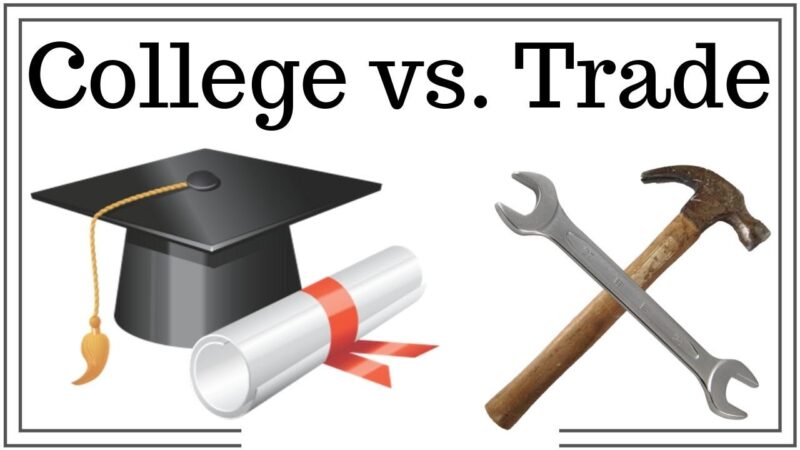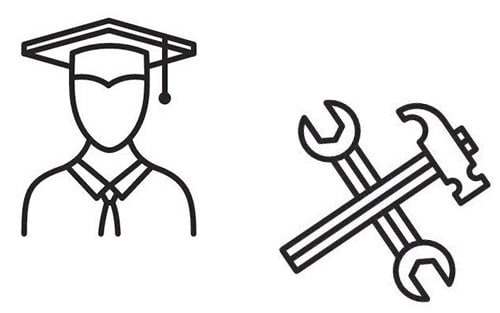Making the right career decision can feel daunting. The choice between pursuing a traditional education or a practical program could define the course of your life, career, and financial future. Many people still believe a degree is the only route to success, but the growing demand for skilled workers is shifting that perspective. Let’s explore why hands-on learning could be the smarter, faster, and more cost-effective path for many.
Key Points
- Hands-on programs provide practical skills for immediate employment.
- Traditional education comes with higher costs and longer completion times.
- The right path depends on personal goals, financial situation, and career aspirations.
Rethinking the Path to Success

For years, society has linked success to a degree from a university. This idea has overshadowed other valuable opportunities, such as skills-based programs. However, times are changing, and more students and parents are exploring alternatives that focus on practical outcomes. Mike Feinberg’s work, as highlighted by the Texas Public Policy Foundation, is a testament to this shift. By championing trade-focused education, Mike Feinberg shows how students can gain life-changing skills and thrive in industries that don’t demand a traditional education.
This approach isn’t about dismissing universities. Instead, it’s about broadening the options and understanding that success has more than one definition.
Financial Realities: Is It Worth the Cost?
The cost of education plays a pivotal role in decision-making. Traditional education typically demands significant financial investment. Tuition, living expenses, and other costs often leave students in debt for decades.
Programs focused on skills tend to have much lower costs. Instead of spending years paying for tuition and interest on loans, students can graduate debt-free or with minimal expenses.
The Financial Breakdown
- Traditional Programs:
- Four-year degrees often cost between $20,000 and $50,000 per year.
- Additional expenses include housing, books, and other fees.
- Practical Alternatives:
- Programs typically cost between $5,000 and $20,000 total.
- Many include tools and certifications as part of the cost.
In the long run, those who choose hands-on learning can start earning sooner and without the financial burden that often accompanies traditional degrees.
Faster Paths to Employment

One of the biggest advantages of hands-on learning is the shorter timeline to employment. Traditional programs often take four or more years to complete, with no guarantee of a job after graduation. Practical programs, however, are designed to equip students with job-ready skills in as little as six months to two years.
Why Timing Matters
Graduating faster means entering the workforce sooner. This allows students to:
- Gain real-world experience while peers are still studying.
- Start earning an income without years of unpaid internships.
- Build professional networks earlier in their careers.
For those who value speed and efficiency, a shorter timeline to employment can make all the difference.
Career Opportunities: Skills That Lead to Jobs
Practical programs focus on teaching specific, in-demand skills. Industries like construction, healthcare, IT, and manufacturing often value expertise over credentials. Programs tailored to these fields equip students with the technical know-how employers seek.
Take healthcare, for example. A medical assistant certificate program may take under a year and lead directly to a stable job. Compare this to a four-year degree, where graduates may still need additional certifications to qualify for the same role.
Hands-On Learning Benefits
- Employers prioritize specific skills over degrees in many industries.
- Programs simulate real-world environments, reducing the need for on-the-job training.
- Certifications demonstrate competency and build credibility.
The Flexibility Factor
Not everyone can afford to attend school full-time, especially those with jobs or family responsibilities. Practical programs often offer flexibility that makes education accessible to a wider range of students.
Evening, weekend, and hybrid formats allow learners to balance work, family, and education. Remote learning options are also growing in popularity, making it easier than ever to access quality training.
For career changers or nontraditional students, this adaptability is invaluable. It means they don’t have to sacrifice current responsibilities to achieve their goals.
The Personal Development Perspective

Education is about more than career preparation. It’s also about personal growth, and both paths offer unique benefits.
Traditional Education
Students often gain:
- Broader knowledge through exposure to multiple disciplines.
- Networking opportunities with peers, professors, and industry professionals.
Practical Programs
Graduates develop:
- Confidence in their abilities through hands-on practice.
- Problem-solving skills tailored to specific challenges in their fields.
While both paths contribute to personal development, practical programs often appeal to those who prefer results-oriented learning.
Myths Surrounding Practical Programs
Many still believe that skills-based learning is a fallback for those who “can’t make it” in traditional education. This stereotype is outdated and incorrect.
Professionals in skilled roles are in high demand, often earning competitive salaries and enjoying job stability. Careers in fields like welding, automotive repair, and tech support require expertise that rivals or exceeds that of degree-holders.
Misconceptions
- Skilled workers often earn as much as, or more than, their degree-holding counterparts.
- Many programs offer clear career progression opportunities.
- Graduates enjoy respect and value in their industries.
Tips for Making the Right Choice
Choosing the right educational path depends on your goals, interests, and circumstances. Here’s how to make an informed decision:
- Evaluate Your Strengths and Interests
Think about what excites you and aligns with your talents. - Consider Your Financial Situation
Weigh tuition costs, potential debt, and post-graduation earnings. - Research Your Desired Career
Find out what employers in your field value more: skills or degrees. - Think About Time Investment
Decide how quickly you want to start working. - Talk to People in the Field
Gain firsthand insights from those already working in your desired profession.
Exploring Hybrid Options

Some students benefit from combining traditional education with hands-on programs. Hybrid options allow students to gain theoretical knowledge and practical skills, making them well-rounded candidates in competitive fields.
For example, an engineering student might complete a certification in computer-aided design (CAD) alongside their degree. This combination enhances their employability while they’re still studying.
Advantages of Hybrid Learning
- Broadens career opportunities by blending theory and practice.
- Makes students more versatile and attractive to employers.
- Provides a safety net, as both pathways can open doors.
Final Thoughts
The choice between a traditional education and hands-on learning depends on your goals and priorities. Programs focused on skills, like those championed by Mike Feinberg, show that success doesn’t always require a degree.
Whether you’re starting your career, changing directions, or exploring options for a loved one, consider what matters most to you: time, cost, or career readiness. By aligning your choice with your aspirations, you’ll set yourself on a path that feels both smart and fulfilling.

